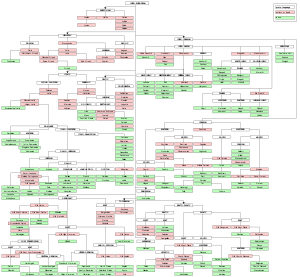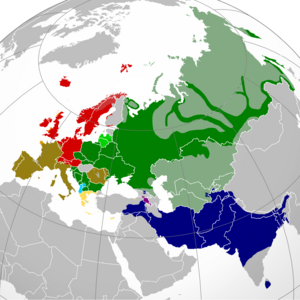History of Indo-European linguistics[edit]
Main article: Indo-European studies
In the 16th century, European visitors to the Indian Subcontinent began to suggest similarities between Indo-Aryan, Iranian and European languages. In 1583, Thomas Stephens, an English Jesuit missionary in Goa, in a letter to his brother that was not published until the 20th century,[6] noted similarities between Indian languages, specifically Sanskrit, and Greek and Latin.
Another account to mention the ancient language Sanskrit came from Filippo Sassetti (born in Florence in 1540), a merchant who travelled to the Indian subcontinent. Writing in 1585, he noted some word similarities between Sanskrit and Italian (these included devaḥ/dio "God", sarpaḥ/serpe "serpent", sapta/sette "seven", aṣṭa/otto "eight", nava/nove "nine").[6] However, neither Stephens's nor Sassetti's observations led to further scholarly inquiry.[6]
In 1647, Dutch linguist and scholar Marcus Zuerius van Boxhorn noted the similarity among Indo-European languages, and supposed that they derived from a primitive common language he called Scythian. He included in his hypothesis Dutch, Albanian, Greek, Latin, Persian, and German, later adding Slavic, Celtic, and Baltic languages. However, Van Boxhorn's suggestions did not become widely known and did not stimulate further research.
The Ottoman Turkish traveller Evliya Çelebi, who visited Vienna in 1665-66 as part of a diplomatic mission, noted a few similarities between words in German and Farsi. Gaston Coeurdoux and others made observations of the same type. Coeurdoux made a thorough comparison of Sanskrit, Latin and Greek conjugations in the late 1760s to suggest a relationship between them. Similarly, Mikhail Lomonosov compared different language groups of the world including Slavic, Baltic ("Kurlandic"), Iranian ("Medic"), Finnish, Chinese, "Hottentot", and others. He emphatically expressed the antiquity of the linguistic stages accessible to comparative method in the drafts for his Russian Grammar (published 1755).[7]
The hypothesis reappeared in 1786 when Sir William Jones first lectured on the striking similarities between three of the oldest languages known in his time: Latin, Greek, and Sanskrit, to which he tentatively added Gothic, Celtic, and Persian,[8] though his classification contained some inaccuracies and omissions.[9]
It was Thomas Young who in 1813[10] first used the term Indo-European, which became the standard scientific term through the work of Franz Bopp, whose systematic comparison of these and other old languages supported the hypothesis. A synonym for "Indo-European" is Indo-Germanic (Idg. or IdG.), which defines the family by indicating its southeasternmost and northwesternmost branches. In most languages this term is dated or less common, whereas in German it is still the standard scientific term.[11] Advocates of Indo-Germanic often claim that "Indo-European" is misleading because many historic and several living European languages (the unrelated Uralic languages, as well as several others, are also spoken in Europe) do not belong to this family. Advocates of Indo-European counter that Indo-Germanic is misleading because many of the European languages included are not in fact Germanic.
Franz Bopp's Comparative Grammar, which appeared between 1833 and 1852, is the beginning of Indo-European studies as an academic discipline. The classical phase of Indo-European comparative linguistics leads from this work to August Schleicher's 1861 Compendium and up to Karl Brugmann's Grundriss, published in the 1880s. Brugmann's junggrammatische reevaluation of the field and Ferdinand de Saussure's development of the laryngeal theory may be considered the beginning of "modern" Indo-European studies. The generation of Indo-Europeanists active in the last third of the 20th century (such as Calvert Watkins, Jochem Schindler and Helmut Rix) developed a better understanding of morphology and, in the wake of Kuryłowicz's 1956 Apophonie, understanding of the ablaut.
Classification[edit]
The various subgroups of the Indo-European language family include ten major branches, given in the chronological order of their emergence according to David Anthony:[12]
- Anatolian (Asia Minor), the earliest attested branch. Emerged around 4200 BCE.[12] Isolated terms in Luwian/Hittite mentioned in Semitic Old Assyrian texts from the 20th and 19th centuries BC, Hittite texts from about 1650 BC;[13][14] extinct by Late Antiquity.
- Tocharian, emerged around 3700 BCE,[12] extant in two dialects (Turfanian and Kuchean), attested from roughly the 6th to the 9th century AD. Marginalized by the Old Turkic Uyghur Khaganate and probably extinct by the 10th century.
- Germanic (from Proto-Germanic), emerged around 3300 BCE,[12] earliest testimonies in runic inscriptions from around the 2nd century AD, earliest coherent texts in Gothic, 4th century AD. Old English manuscript tradition from about the 8th century AD.
- Italic, including Latin and its descendants (the Romance languages), emerged around 3000 BCE,[12] attested from the 7th century BC.
- Celtic, descended from Proto-Celtic, emerged around 3000 BCE.[12] Gaulish inscriptions date as early as the 6th century BC; Celtiberian from the 2nd century BC; Primitive Irish Ogham inscriptions 5th century AD, earliest inscriptions in Old Welsh from the 8th Century AD.
- Armenian, emerged around 2800 BCE.[12] Alphabet writings known from the beginning of the 5th century AD.
- Balto-Slavic, emerged around 2800 BCE,[12] believed by most Indo-Europeanists[15] to form a phylogenetic unit, while a minority ascribes similarities to prolonged language contact.
- Slavic (from Proto-Slavic), attested from the 9th century AD (possibly earlier; see Slavic runes), earliest texts in Old Church Slavonic.
- Baltic, attested from the 14th century AD; for languages attested that late, they retain unusually many archaic features attributed to Proto-Indo-European (PIE).
- Hellenic, emerged around 2500 BCE.[12] Fragmentary records in Mycenaean Greek from between 1450 and 1350 BC have been found.[16] Homeric texts date to the 8th century BC. (See Proto-Greek, History of Greek.)
- Indo-Iranian, emerged around 2200 BCE,[12] attested circa 1400 BC, descended from Proto-Indo-Iranian (dated to the late 3rd millennium BC).
- Indo-Aryan or 'Indic languages', attested from around 1400 BC in Hittite texts from Asia Minor, showing traces of Indo-Aryan words.[17][18] Epigraphically from the 3rd century BC in the form of Prakrit (Edicts of Ashoka). The Rigveda is assumed to preserve intact records via oral tradition dating from about the mid-2nd millennium BC in the form of Vedic Sanskrit.
- Iranian or Iranic, attested from roughly 1000 BC in the form of Avestan. Epigraphically from 520 BC in the form of Old Persian (Behistun inscription).
- Dardic
- Nuristani
- Albanian, attested from the 14th century AD; Proto-Albanian language likely evolved from Paleo-Balkan predecessors.[19][20]
In addition to the classical ten branches listed above, several extinct and little-known languages have existed:
- Illyrian — possibly related to Messapian, Albanian, or both
- Venetic — close to Italic and possibly Continental Celtic
- Liburnian — doubtful affiliation, features shared with Venetic, Illyrian and Indo-Hittite, significant transition of the Pre-Indo-European elements
- Messapian — not conclusively deciphered
- Phrygian — language of the ancient Phrygians, possibly close to Thracian, Armenian, Greek[citation needed]
- Paionian — extinct language once spoken north of Macedon
- Thracian — possibly including Dacian
- Dacian — possibly very close to Thracian
- Ancient Macedonian — proposed relationships to Greek, Illyrian, Thracian, and Phrygian.
- Ligurian — possibly close to or part of Celtic.[21]
- Sicel - an ancient language spoken by the Sicels (Greek Sikeloi, Latin Siculi), one of the three indigenous (i.e., pre-Greek and pre-Punic) tribes of Sicily. Proposed relationship to Latin or proto-Illyrian (Pre-Indo-European) at an earlier stage.[22]
- Lusitanian — possibly related to (or part of) Celtic, Ligurian, or Italic
- Cimmerian – possibly Iranic, Thracian, or Celtic




No comments:
Post a Comment